But why does it happen so consistently? It‘s not one thing, it’s a series of moments throughout the customer journey. Understanding that journey is everything, and that's where customer journey maps become invaluable.
While I can‘t promise you’ll predict every customer‘s move perfectly, I can show you how to build a map that tracks the critical moments that matter. A good customer journey map doesn’t just show you what customers are doing — it shows you why.
In this post, I‘ll walk you through my exact process for building customer journey maps that drive results. We’ll cover what a journey map is (and isn't), how to gather the right data, and a step-by-step framework to get it done right.
Table of Contents
- What is the customer journey?
- The Customer Journey Mapping Process
- Steps for Creating a Customer Journey Map
- Customer Journey Mapping Best Practices
- What is a customer journey map?
- What data is necessary for customer journey mapping?
- What's Included in a Customer Journey Map?
- Types of Customer Journey Maps and Examples
- Customer Journey Mapping Examples and Templates
- Free Customer Journey Map Templates
- Customer Journey Map Design
- Benefits of Customer Journey Mapping
Customer Journey vs. Buyer Journey
I've noticed a lot of businesses get confused when it comes to understanding the difference between the customer journey and the buyer journey. It’s a common point of confusion, but the distinction is quite important.
Think of it this way:
- The buyer's journey is the generic path someone takes. It’s universal. They realize they have a problem (Awareness), research solutions (Consideration), and choose one (Decision).
- The customer's journey is the specific path they take with your brand. It’s made up of the unique customer touchpoints you create to guide them through their buyer journey.
At Skybound, where I work now, our customer journey for a new comic book launch might start with an ad on social media (Awareness), lead to a landing page with early reviews (Consideration), and end with a pre-order Shopify or Kickstarter store (Decision). By mapping out that specific journey, we’re making sure every interaction is intentional and impactful, rather than just hoping for the best.

Your brand’s customer journey stages might look different, and that’s okay. What matters is starting with a clear plan. Let’s dig into how you can create a customer journey map to visualize it all.
What is a customer journey map?
A customer journey map is a visual representation of the customer's experience with a company. It also provides insight into the needs of potential customers at every stage of this journey and the factors that directly or indirectly motivate or hinder their progress.
By mapping your customer journey, you can use the information to improve the customer experience, increase conversions, and boost customer retention.
Keep in mind: The customer journey map is not to be confused with a UX journey map. Here’s the difference:
What is UX journey mapping?
A UX journey map represents how a customer experiences their journey toward a specific goal or completing a particular action. I’ve found this term is often used interchangeably with “customer journey map,” especially when the goal is a purchase.
However, UX journey mapping can also be used to map the journey towards other goals, like successfully using a new feature in a SaaS product for the first time. It’s a bit more granular.
Why is customer journey mapping important?
I’ve learned that the customer journey isn’t as simple as it looks. It’s easy to think: offer a product → customer buys. But honestly, it’s way more intricate.
Before a customer even knows about your product, they need to know they have a problem and that it needs solving. Sometimes you need to provide additional education to get them to that point.
Throughout their journey, they’ll hit different touchpoints. Maybe they’ll see a competitor’s ad, read a review, hop on a sales call, or try out a demo. Each of those interactions shapes how they feel about your brand.
Here’s something interesting: A Salesforce report found that 80% of customers value their experience with a company just as much as the product itself. That’s not a small number. It tells me that the how is just as important as the what.
By mapping out the customer journey, I’ve seen how it gives marketing, sales, and service teams a clear understanding of each stage. It reduces friction and leads to happier customers. And when we meet customer needs quickly? We see higher brand loyalty.
That’s huge, and it’s why I believe that understanding this journey is non-negotiable for any business that wants to grow.
What data is necessary for customer journey mapping?
When I’m mapping the customer journey, I focus on real data, not assumptions. I think of it in two main buckets: solicited data (what customers tell me directly) and unsolicited data (what their actions tell me).
As email strategist and customer journey strategist, Lindsay Hope explains, “You don’t want just any data. You need to dig deep to get to the actionable insights that show you exactly how your audience thinks, feels, and behaves at each stage of their journey. Unfortunately, most businesses get stuck because they think they know what their customers want. But assumptions ≠ reality. You have to collect the right data, so you’re working with facts, not guesses.”
Customer Surveys and Interviews
I find that asking customers directly through surveys or interviews reveals valuable insights into their experiences, pain points, and how they use the product. This is my go-to for solicited data because I can ask for it specifically.
In my experience, tools like Net Promoter Score (NPS) surveys, customer satisfaction (CSAT) scores, and even simple social media polls give me a pulse on how customers feel.
I few things I regularly do:
- Use post-purchase surveys to understand what they loved or struggled with during their buying journey.
- Talk with customers one-on-one to understand the deeper motivations behind their decisions.
- Talk with people who didn’t buy to understand why. This one can be difficult, but is often the most insightful.
While I love this type of customer information, it does have limitations. It relies on customers sharing their real opinions. In interviews, for example, people are often polite and might skew positive even if things could have gone better. And, a survey typically only reflects a specific touchpoint and may not reflect their entire experience.
Pro tip: Hope shares, ”When collecting solicited data, ask questions to highlight feelings and friction. (Not just what your customer did but why they made that choice.) For example: Instead of ‘What features did you like?’ ask ‘What made you confident this was the right solution?’”
Unsolicited Data
This is the other side of the coin. It’s the behavioral data customers leave behind without being asked. It’s often more quantitative and reveals what they actually do, not just what they say they do.
The data I find beneficial includes:
- Website behavior — the pages they view, the order of pages they click, bounce rates, and abandoned cart information.
- Email behavior — open rates, click rates, and other types of engagement.
- Social media mentions and reviews — public comments can help us identify areas for improvement and areas that delighted customers.
- Operational data — this is internal data like delivery delays or support ticket response times that help us improve the way we serve our customers.
For example, if we find that customers are abandoning their carts at the payment stage, we may identify long load times or our payment options as the causes of friction.
The Importance of Both Data Types
While unsolicited data often lacks the context that solicited feedback provides, we typically get more of it because we’re not relying on customer motivation to respond.
When you use the two types of data together, you’ll gain a more comprehensive view of your customer journey and any gaps.
My favorite part of combining solicited interviews with unsolicited reviews is the absolute goldmine of voice of customer data. It’s the exact language customers use, which is pure gold for marketing.
Ivan Venberg, Head of Content at Yango Ads, agrees and offered this recommendation: “Pay attention to the language people use. I recommend Sarah Winters’ book Content Design, where she discusses how she struggled to attract users to the UK government site due to her use of the term ‘fracturing.’ By simply talking to users, she discovered that “fracking” was the term they used, which dramatically improved conversions.”
A real-world example I’ve seen: you might get positive feedback from potential customers, but they don’t go through with purchasing. By looking at the unsolicited data, you may learn that this happens after they see the shipping costs.
Or, your support transcripts might show high CSAT scores for your agents’ helpfulness, but the unsolicited data (like ticket resolution time) shows people are waiting a long time and are frustrated.
The bottom line? Both types of data are invaluable for building accurate customer journey maps.
Pro tip: Create a “language bank” from unsolicited data, such as reviews, chats, and social posts. Regularly cross-reference it with your marketing and UX. When your words mirror your customers’, you reduce friction, build trust, and boost conversion without spending an extra dollar.
This process provides insights that help you understand how customers experience their journeys and identify potential bottlenecks.
It’s important to remember that most customer journeys aren’t linear. Instead, buyers often experience a back-and-forth, cyclical, multi-channel journey with multiple touchpoints.
What is a touchpoint in a customer journey map?
I want to make sure we’re on the same page about what a touchpoint really means here. Touchpoints refer to every instance your business comes in direct contact with a potential or existing customer. It could be online, in-person, through your messaging, website, or app, and any number of other circumstances. What you need to know is that every time your customer interacts with you, they form an opinion of your business.
Now for the fun part, building the map. Here’s the framework I use to turn data into a story that my whole team can understand and act on.
1. Start with a customer journey map template.
Why reinvent the wheel? Honestly, starting from a blank page is intimidating and can lead to what I call “analysis paralysis.” I’ve saved countless hours by starting with HubSpot’s free customer journey map templates. They provide a common language and structure that helps align teams from the start.
Using a proven template ensures everyone is looking at the same core components, which can lead to a noticeable improvement in product and service offerings.
2. Set clear objectives for the map.
Before you think about data, you have to define your purpose. A map without a destination is just a drawing. I always start by asking my team:
- What is the most important question this map needs to answer?
- Who is the primary audience for this map (e.g., product team, marketing leadership)?
- What specific experience are we examining (e.g., the first 30 days of a new user, the path from a social ad to purchase)?
From my experience, a map without a clear, guiding question becomes a messy, unfocused document. Are you trying to improve the onboarding experience for new users? Or are you trying to understand why customers churn after six months? Be specific. If you don’t have a buyer persona yet, trust me, it’s worth creating one. It’s a fictional profile that reflects the demographics and psychographics of your typical customer. For me, it has always been the anchor that keeps the journey map focused on the right audience.
3. Profile your personas and define their goals.
Now it’s time for the deep research that breathes life into your map. This is where having customer journey analytics is super helpful, but if you don’t have a sophisticated setup, don’t worry. Simple tools work wonders.
Personally, I find questionnaires and user testing invaluable for gathering customer feedback. The key is to reach out to real customers or prospects. Getting feedback from the right people is key.
Here are some of the questions I always come back to:
- How did you hear about us? (uncovers initial touchpoints)
- What problem were you trying to solve that led you to our website? (reveals motivation)
- Walk me through the steps you took. What were you thinking at each point? (maps the actual journey)
- Was there any point where you felt stuck or confused? (identifies friction)
- What was the deciding factor that made you purchase, or not purchase? (pinpoints the critical moment)
- On a scale of 1-10, how easy was it to find what you needed? (measures effort)
- If you contacted support, how did that experience make you feel? (gauges emotional impact)
- If you had a magic wand, what’s one thing you would change about the process? (opens the door for solutions)
Pro tip: Use HubSpot’s free buyer persona tool to organize the details you gather from customer feedback into a coherent profile.
The B2B Angle
The journey can look very different in a B2B context. As CEO and Founder of Keystone Click, Lori Highby, works primarily with B2B companies and has a brilliant framework. She suggests asking the same five questions at every stage of the buyer journey:
- What is the prospect thinking and feeling?
- What actions are they taking?
- What are their touchpoints with the business?
- Where is there hesitation or friction?
- What are our opportunities to add value?
Highby and her team apply this to five stages: awareness, consideration, action, experience, and advocacy. She says this consistency is important “because it opens up the opportunity to get a holistic view of the customer experience while identifying trends and opportunities to maximize the overall experience you are providing.”
4. Highlight your target customer personas.
After gathering all that rich information, it’s tempting to map everyone’s experience. Resist the urge. A customer journey maps follow the path of a specific customer type. Trying to map everyone at once is like trying to listen to every conversation in a crowded room, you’ll just end up with the noise.
For your first map, I strongly recommend choosing your most common customer persona. Focus on the path they would most likely take when engaging with your business for the first time. I often use a marketing dashboard to compare different personas and choose the one that represents either our biggest opportunity or our most significant pain point. Don’t worry, any personas you leave out can always be mapped later.
5. List out all touchpoints.
Now we get granular. I always start by brainstorming every single place a customer might interact with our brand. These moments, however small, are where opinions form. A display ad, a 404 error page, a confirmation email, a social media comment… They’re all touchpoints that matter.
It’s easy to get tunnel vision and only think about your website. I like to take a broader approach and consider social media, email campaigns, paid ads, third-party review sites, and even customer support interactions. Mapping these out helps spot inconsistencies and areas of improvement in your customer journey.
Once you have your list, you’ll notice patterns start to emerge. Are customers using fewer touchpoints than you expected? They might be leaving the journey too early. Are they using far more? Your process might be too complicated. Either way, it’s a signal to tell you how smooth or bumpy the journey really is.
One common exercise is running internal workshops where employees from different teams point out moments when the product or brand leaves an impression on customers. Their perceptions or data-points can drive this.
You can see the HubSpot team mapping these touch points with sticky notes in the image below. Seeing it all laid out helps identify inconsistencies in how you communicate with customers. I’ve been in many of these scrum type working sessions at various startups and it’s a proven method. I guess you can say the proof is in the pudding.

6. Determine the resources you have and the ones you’ll need.
A journey map is more than a diagnostic tool for the customer experience. It’s also a diagnostic for your internal resources. As I work through the map, a clear picture of our internal strengths and weaknesses starts to emerge.
For example, a map I worked on once showed that our support team was swamped with a set of questions that could easily be deflected by adding some smart self-service solutions. The map didn’t show a customer pain point but highlighted an internal resource gap. In another case on the e-commerce side of things, I remember our team spotting underused touchpoints in our email sequence and realizing we needed a better marketing automation tool to engage customers effectively.
Including these resource gaps right on the map helps me predict their impact and makes it much easier to build a case when I need to ask leadership for support or investment.
7. Take the customer journey yourself.
This is an important step for building empathy. Data and surveys are essential, but nothing replaces walking in your customer’s shoes. For me, a customer journey map isn’t finished until I’ve experienced the journey firsthand. This is where you uncover the subtle frustrations that data alone can’t convey.
I follow the exact path for each persona. I use their keywords in Google, I click on the same ads, I read the same emails, and I try to complete the same tasks on our website. For a recent project, I did all of the following:
- Searched for my product using the top 3 keywords our customers use.
- Searched for our main competitor to see what that experience felt like.
- Signed up for my own company’s email list with a new address.
- Navigated our website and app on both desktop and mobile with fresh eyes.
- Reached out to our own support team with a common, simple question.
This “reality check” provides invaluable context. Analytics might show a high bounce rate on a page, but when you experience the slow load time and confusing navigation yourself, you feel the customer’s frustration.
8. Analyze your results.
With your customer journey map populated with data and firsthand experiences, it’s time to connect the dots. This is about finding patterns and asking “why?”
I gather my team, and we ask questions like:
- Where are customers dropping off, and what was happening right before?
- Are we truly meeting their needs at each stage, or just pushing our own agenda?
- Which touchpoints are our “bright spots” that delight customers? How can we replicate that?
- What is the biggest source of friction or emotional frustration in this entire journey?
I’ve found that this approach helps identify where customer needs aren’t being met. It allows us to move from “I think this is a problem” to “We know this is a problem, and here’s the impact.”
Keep an open mind as you’re almost guaranteed to find something unexpected that challenges your internal assumptions.
9. Update your map over time.
Finally, remember that customer journey maps are living documents, not static artifacts to be filed away. Your customers evolve, your products change, and the market shifts. Your map should reflect that reality.
How often should you update your customer journey map?
I recommend reviewing your maps monthly or quarterly. By continuously layering in new data analytics and customer feedback, we can spot roadblocks early. Using a collaborative tool like Google Sheets or a dedicated platform helps keep everyone on the same page.
I’ve also found that holding regular meetings after new product launches or feature updates to discuss how they might shift the customer journey is key to staying ahead of the curve.
Featured Resource: Customer Journey Map Template
Use HubSpot’s free customer journey map template to get started. I’ve found it gives you a solid framework right out of the box, saving time and making it easier to organize the entire experience.
It helps you pinpoint exactly where your product, marketing, or support has friction, so you can start fine-tuning what matters most.
Download a free, editable customer journey map template.
1. The Buying Process
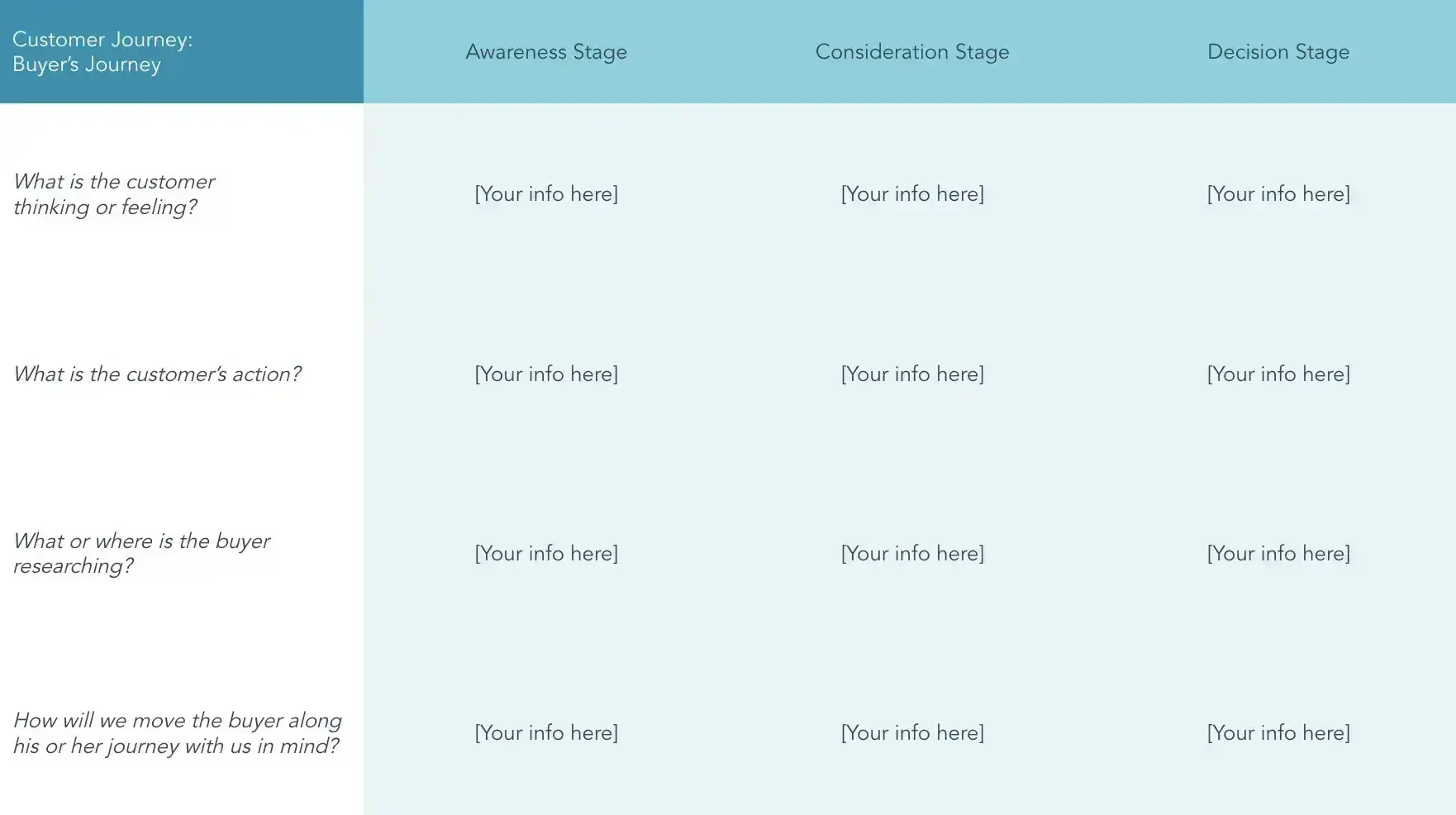
This is the skeleton of your map. It outlines the fundamental stages a customer moves through. While I always start with the classic “Awareness, Consideration, Decision” framework, I know the real journey is never that clean. When I’m mapping, I’m looking for the detours. I gather data from our CMS, analytics, and sales tools to see the actual path. Do they jump from a blog post (Awareness) back to social media for reviews before hitting our price page (Consideration)? Mapping this basic flow is the first step to understanding their logic, not just ours.
2. Emotions

This is where the map gets its heart. A customer isn’t a robot executing steps, they’re a person trying to solve a problem, and that journey is packed with emotion. Capturing these feelings is how we find the moments that matter most.
I like adding design elements to the journey map, things like emojis to represent the emotional highs and lows the customer goes through. A high number of support tickets isn’t just an operational metric, it’s most likely a red flag for customer frustration. I look for these emotional signals in NPS comments, online reviews, and especially in one-on-one interviews.
3. User Actions

If the buying process is the skeleton and emotions are the heart, user actions are the muscles. This layer details what the customer is actually doing at each stage. It’s not enough to know they’re in the “Consideration” phase; I want to know if they’re downloading an ebook, watching a demo video, or clicking through every photo in a product gallery. I like to track things like page-view sequences, CTA clicks, and email engagement because each action tells a story.
For example, if a user visits the pricing page three times in a day but doesn’t buy, that action tells me they’re interested but something is holding them back.
4. User Research

I call this layer “playing detective.” It’s about understanding the customer’s inner monologue by looking at what they research before they act. In the awareness stage, they aren’t searching for our brand; they’re Googling their problem. It’s our job to know what those terms are so we can be the ones to provide the answer.
I like to analyze everything from search engine queries and chatbot logs to competitor reviews and social media chatter. The goal is to meet them where they are, with the information they need, before they even know to ask us for it.
5. Solutions

This is the “So what?” layer, and frankly, it’s the only one that ultimately matters for the business. A beautiful map that doesn’t lead to action is just a piece of art. For every point of friction or negative emotion uncovered, it’s important to brainstorm concrete solutions.
The goal is to transform moments of friction into moments of customer delight. Can we simplify the checkout process? Can we create a better FAQ to reduce support tickets? Can we add a video to clarify a complex feature? This is where the map becomes a strategic plan, guiding how we improve the entire customer experience.
Types of Customer Journey Maps and Examples
There are four main types of customer journey maps, each with unique benefits.
To get started, you’ll need to choose which customer mindset to focus on. This choice will guide you in selecting the right template. Pick the one that makes the most sense for your company.
1. Current State Customer Journey Map
This is the bread and butter of journey mapping. They visualize the actions, thoughts, and emotions your customers currently experience while interacting with your company. I’ve used these to find and fix friction points. For example, at Trendy Butler, I used a current state map to analyze our subscription cancellation flow, which helped us identify a confusing step and reduce unintentional churn.
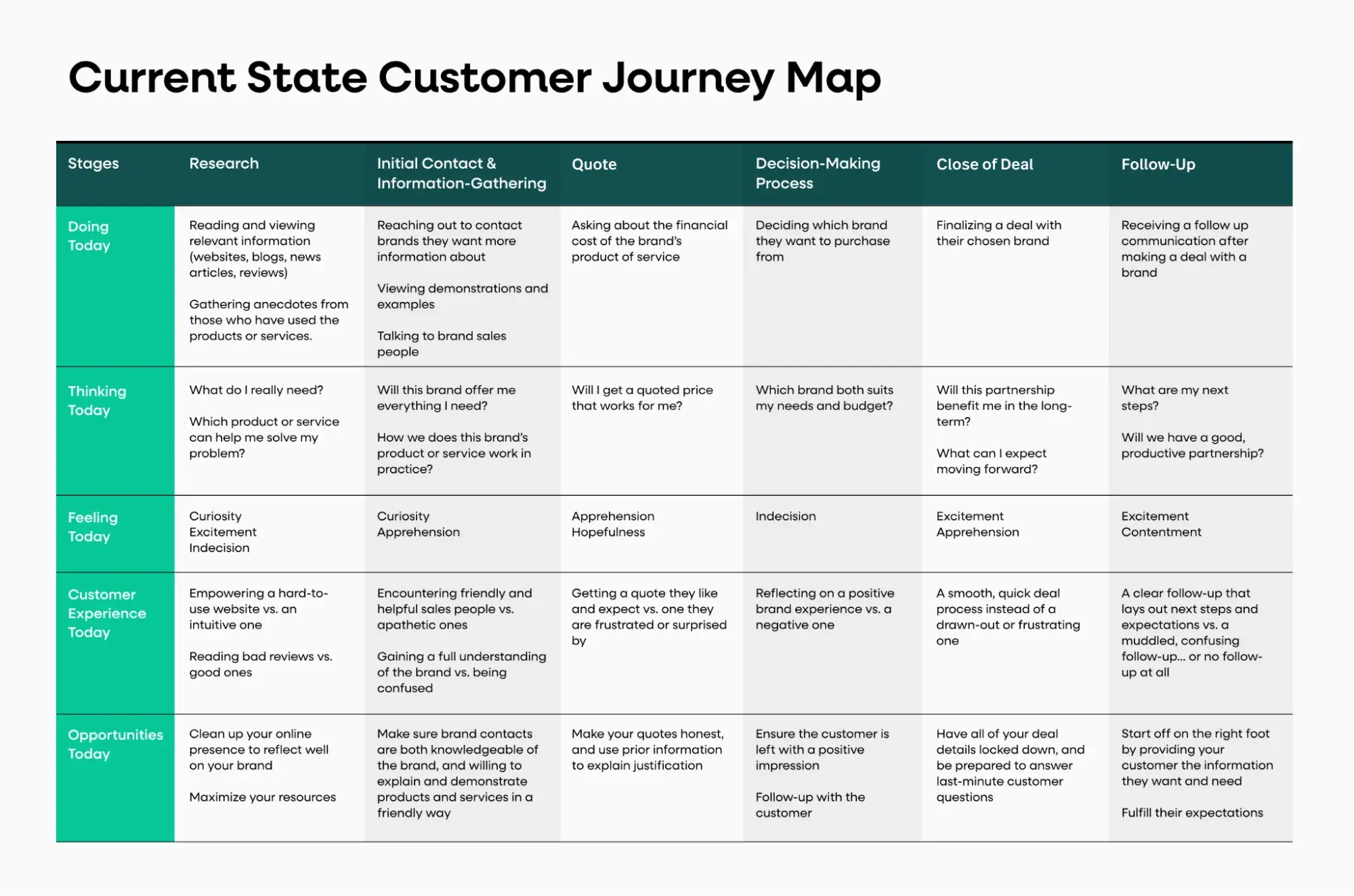
2. Day in the Life Customer Journey Map
These customer journey maps visualize the actions, thoughts, and emotions your customers currently experience in their daily activities, whether or not that includes your company.
This type gives a broader lens into your customers’ lives and what their pain points are in real life.
I find these are best for addressing unmet customer needs before customers even know they exist. When I work with gaming communities, we use this type to understand when players are most active on social media, which helps us schedule community events and announcements for maximum impact.
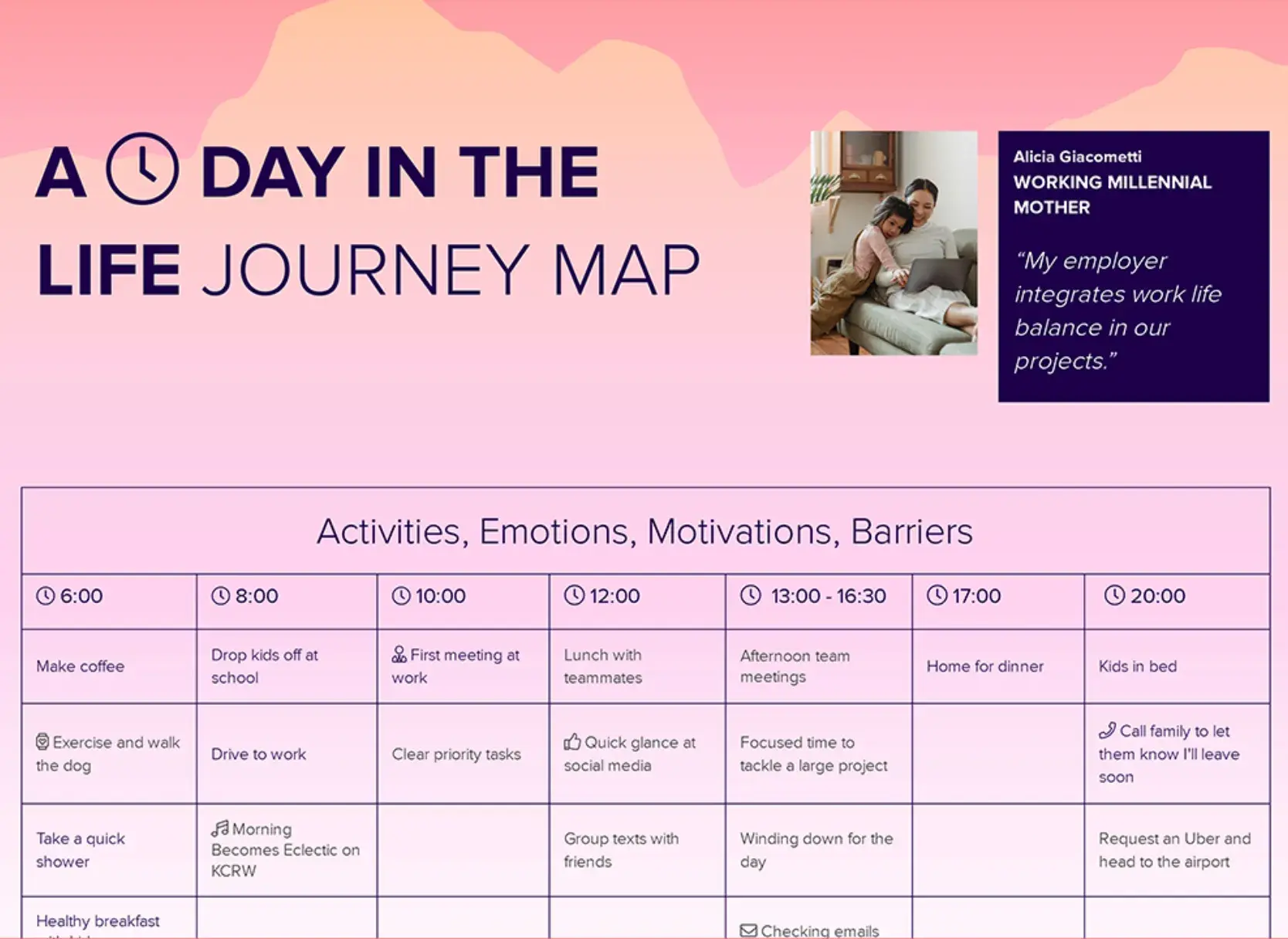
3. Future State Customer Journey Map
These customer journey maps visualize what actions, thoughts, and emotions your customers will experience in future interactions with your company. Based on where they are now, you can project where your business will fit in later.
These maps are best for illustrating your vision and setting clear, strategic goals. I’ve used future state maps when launching a new subscription SaaS tier model with varying service offerings to align teams around the ideal customer experience we wanted from day one.
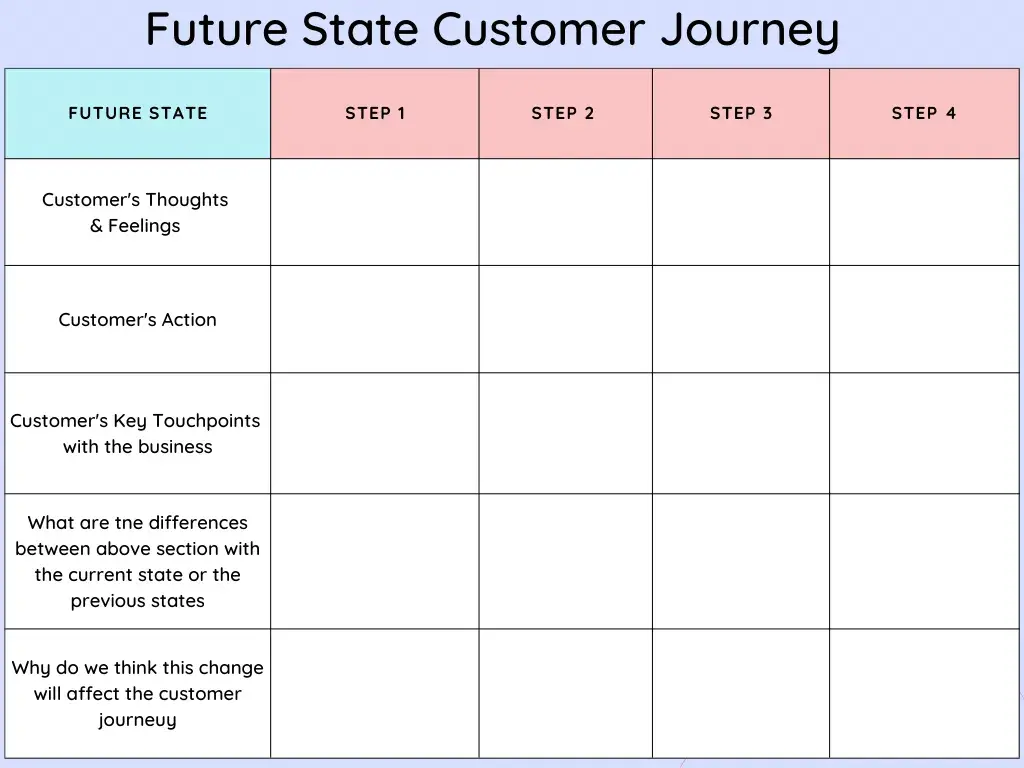
4. Service Blueprint Customer Journey Map
These customer journey maps begin with a simplified version of one of the above map styles. Then, they layer on the factors responsible for delivering that experience, including people, policies, technologies, and processes.
I’ve experimented with service blueprints to identify the root causes of pain points in the current customer journeys or figure out the steps needed to form desired future customer journeys. They’re great for digging into the “backstage” operations. I’ve used a service blueprint at Skybound to map out the entire support ticket lifecycle, which showed me a few bottlenecks in our escalation process that we were then able to fix.
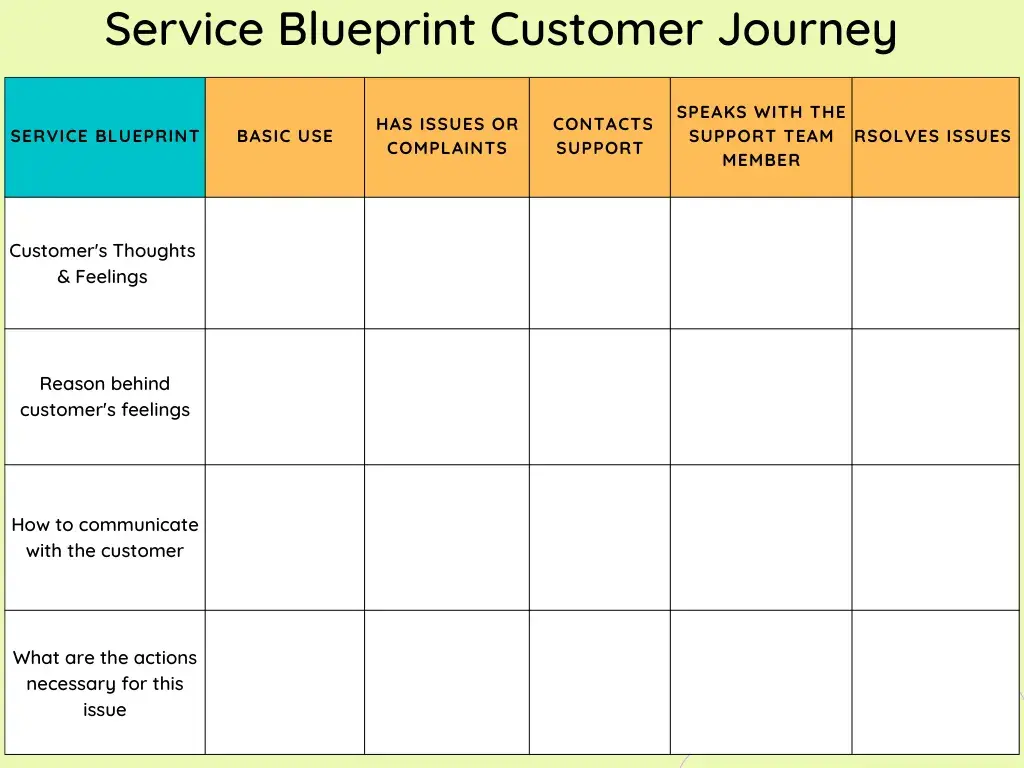
If you want a look at an actual customer journey map that HubSpot has recently used, check out this interview they conducted with Sarah Flint, previous Head of Operations for Technology and Strategy at HubSpot. She talks about how her team put together their map (below) and what advice she would give to businesses starting from scratch.

Customer Journey Mapping Examples and Templates
Here are some examples I’ve drawn inspiration from when building a customer journey map:
1. HubSpot’s Customer Journey Map Templates
HubSpot’s free Customer Journey Map Templates provide an outline for companies to understand their customers’ experiences.
The offer includes the following:
- Buyer’s Journey Template
- Current State Template
- Lead Nurturing Mapping Template
- Future State Template
- A Day in the Customer’s Life Template
- Customer Churn Mapping Template
- Customer Support Blueprint Template
Each of these templates helps organizations gain new insights into their customer base and help make improvements to product, marketing, and customer support processes.
Download them today to start working on your customer journey map.
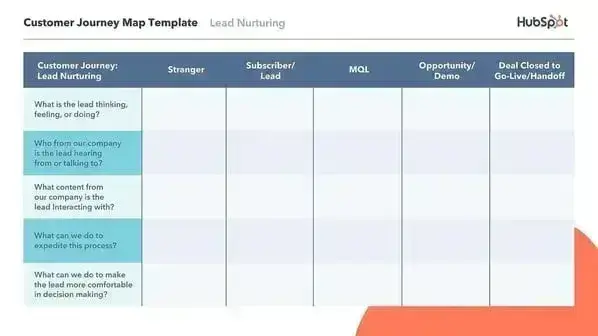
2. B2B Customer Journey Map Example
This B2B customer journey map from Asana breaks the customer experience into six distinct stages. I like how it covers the full lifecycle, starting well before the sale at the “Awareness” stage and extending all the way to “Retention/Advocacy” after the purchase is complete.
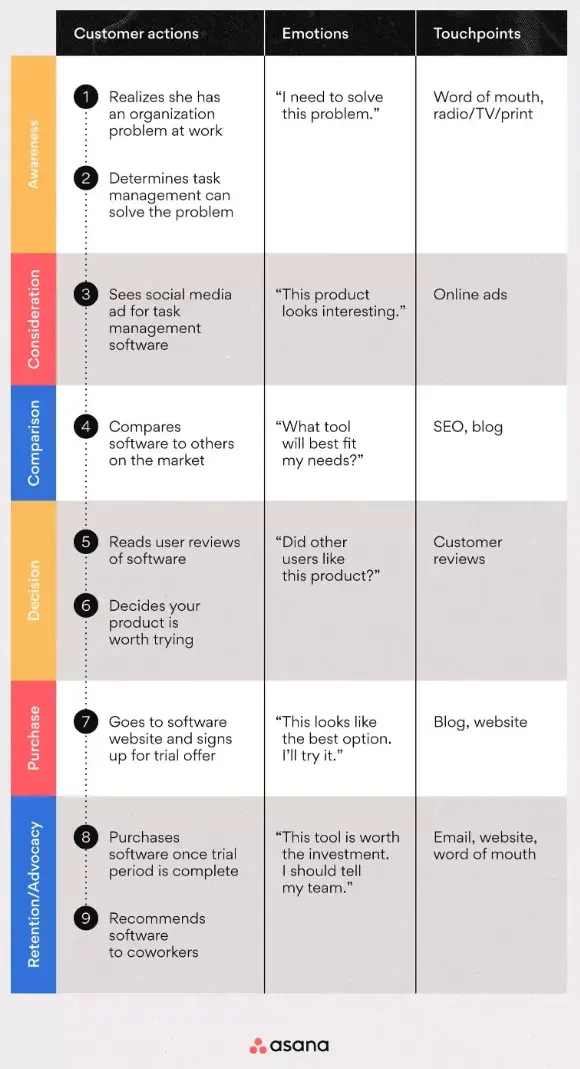
What makes the map so practical is how it gets the team to think from the customer’s perspective. For each stage, it maps out the specific customer actions (like “Compares software”), the emotions or internal monologue (like “What tool will best fit my needs?”), and the corresponding touchpoints (like “SEO, blog”).
This structure gives every team, from marketing to sales and support, a clear guide on where to focus their efforts to address customer needs and feelings at each specific point in their journey.
3. Ecommerce Customer Journey Map Example
This ecommerce journey map for Nike is a great example of how to visualize the entire customer lifecycle across five key stages, from Awareness to Loyalty. What I find particularly effective here is the ‘Experience’ row, which includes a line graph that visually tracks the customer’s emotional journey from hesitant to happy. It’s a powerful way to build empathy.
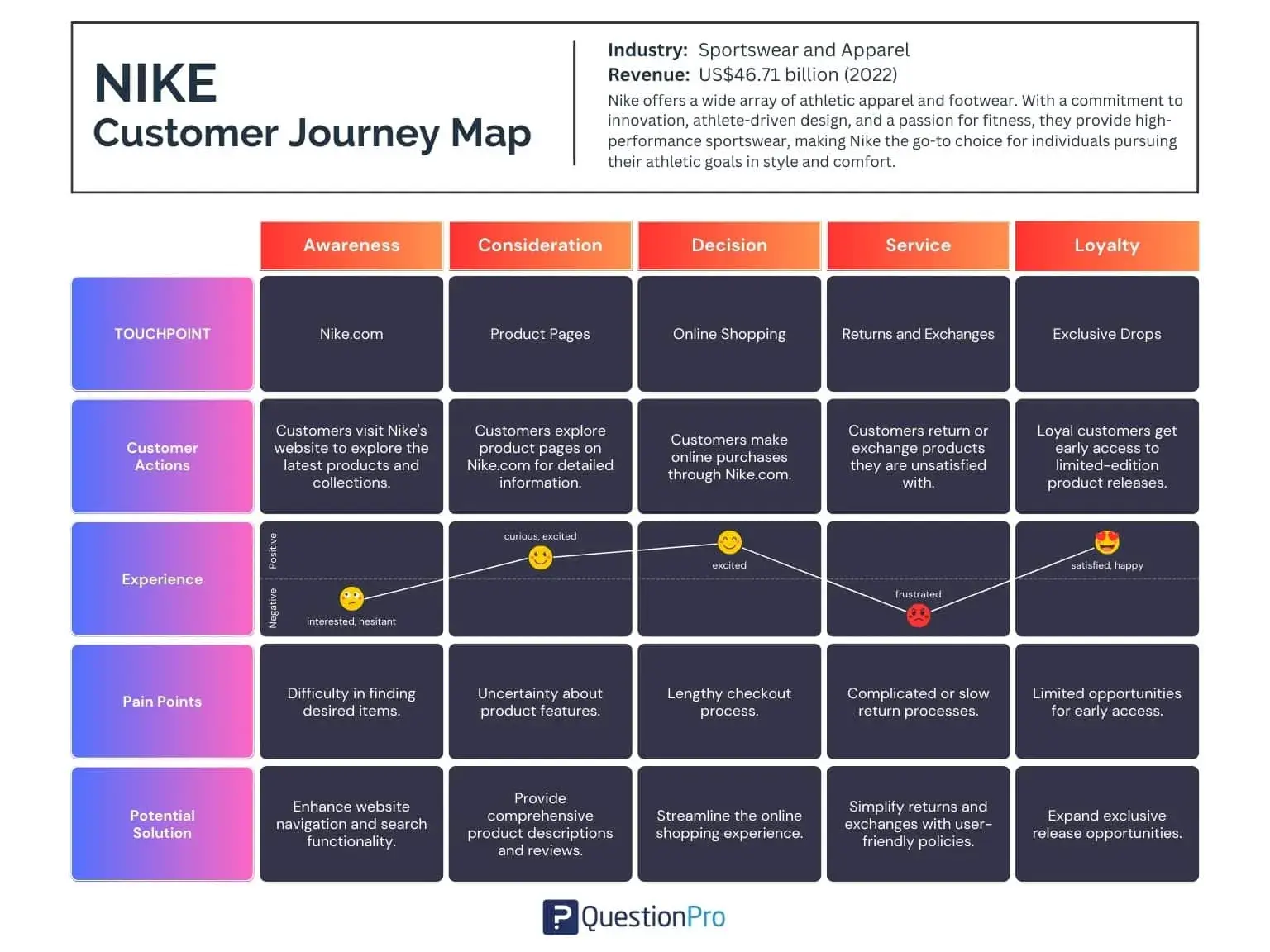
But this map goes beyond tracking feelings, it’s incredibly actionable. For each stage, it directly links a specific ‘Pain Point’ with a ‘Potential Solution.’ For instance, it identifies that a ‘Complicated or slow return process’ in the Service stage leads to frustration and proposes a direct fix: ‘Simplify returns and exchanges.’
This problem/solution format turns the map from a simple diagram into a strategic blueprint for improving the customer experience at every touchpoint.
4. Future B2C Customer Journey Map Example
This Future State Customer Journey Map is a perfect example of a strategic tool for designing an ideal B2C experience from the ground up. I’ve often used templates like this to move from analyzing what is to defining what should be. It methodically walks you through five key stages, forcing you to think intentionally about every step of the improved journey you want to create for your customer.
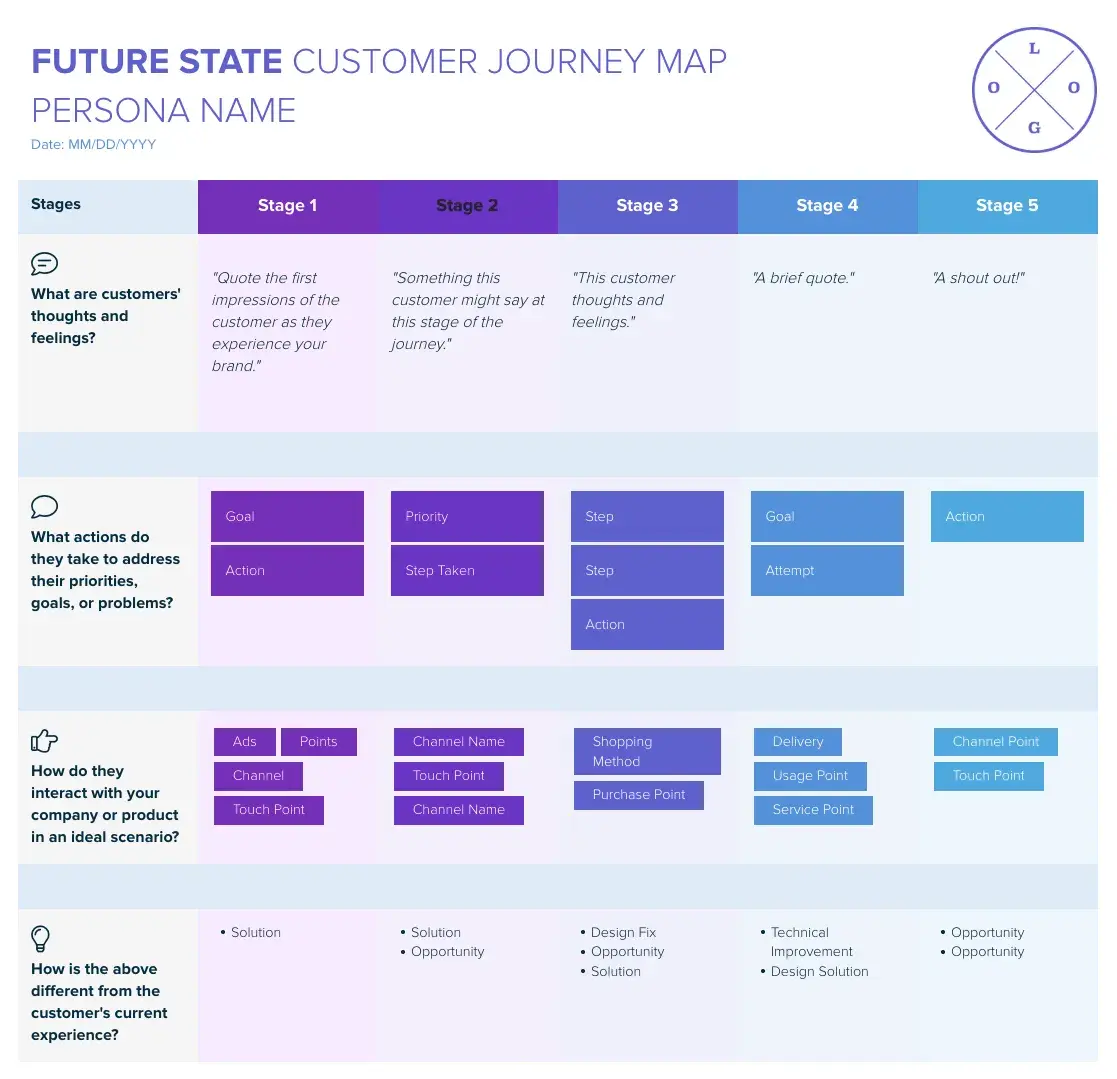
What makes this template so effective is how it prompts you to define the ideal scenario. You’re not just mapping out customer thoughts and actions, you’re designing how they should interact with your product through specific touchpoints like ‘Ads’ or streamlined ‘Shopping Method.’
The final row, “How is the above different from the customer’s current experience?” is where the strategy really comes together. It pushes you to articulate the specific ‘Solution’ or ‘Design Fix’ that will deliver this better B2C experience, turning a wishlist into an actionable plan.
5. Retail Customer Journey Map Example
When I look at a journey map, I want to see the whole story, and this retail map really delivers on that. It goes way beyond the usual five stages, breaking the customer lifecycle into nine distinct phases from the very first moment of awareness all the way to becoming a loyal advocate who refers others. It’s the level of detail that I find truly valuable.
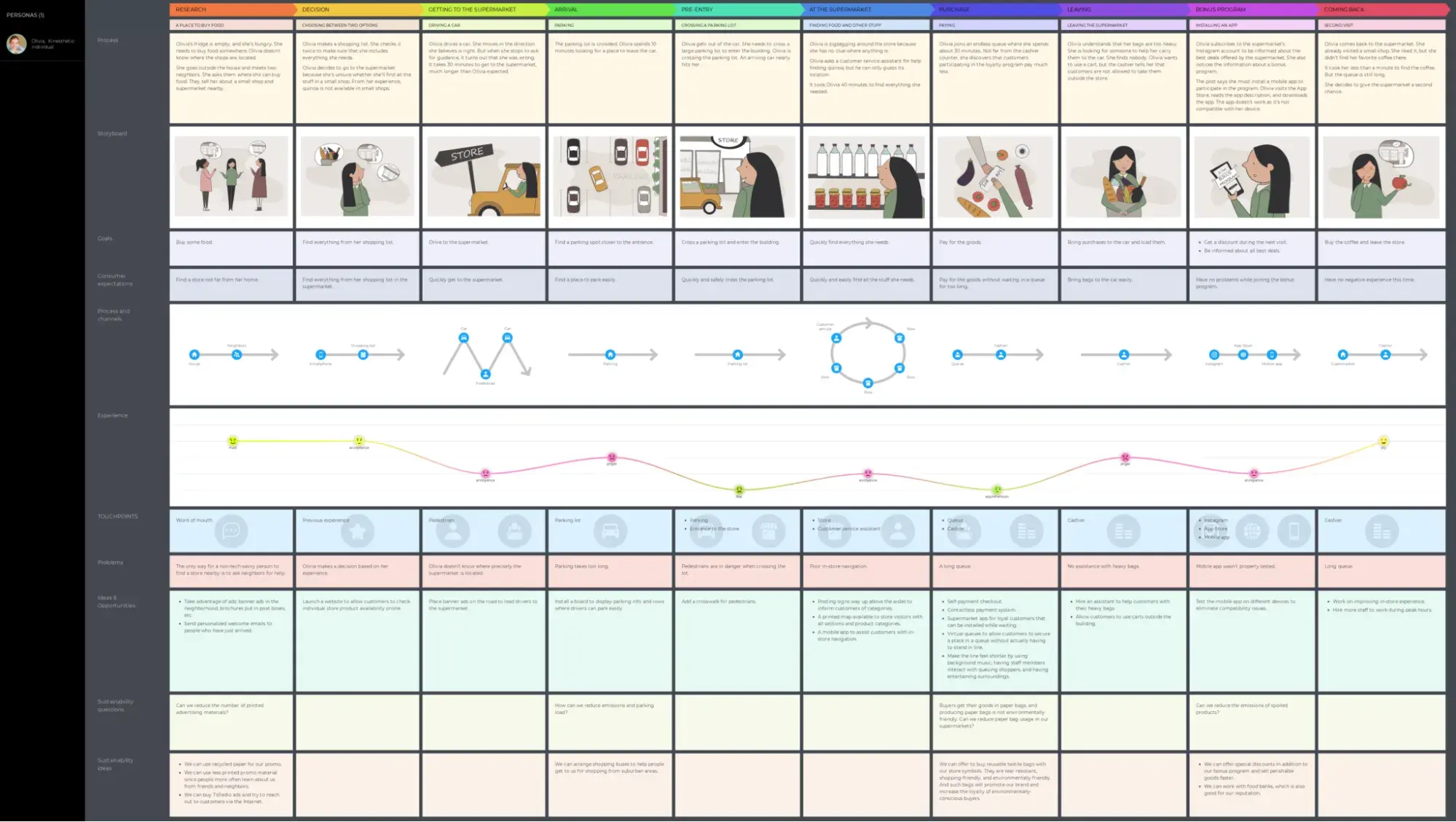
What I appreciate here is how it gets inside the customer’s head at every step by splitting the experience into “Thinking,” “Doing,” and “Feeling.” This gives you a complete, empathetic picture of their internal mindset and external actions. You can see this emotional journey visualized perfectly in the experience graph, which shows all the peaks and valleys along the way.
Free Customer Journey Map Templates
1. Free Current State Template
If you’re using this template for a B2B product, the phases can be customized to reflect a more specific sales and adoption cycle. For example, if you were mapping the journey for a client signing up for a new project management software, the phases might be ‘Initial Research,’ ‘Product Demo,’ ‘Trial Period,’ ‘Subscription Purchase,’ and ‘Team Onboarding.’
These stages are more granular and track the customer’s direct interactions, giving you a clearer view of their decision-making process.
Get an interactive current state template.
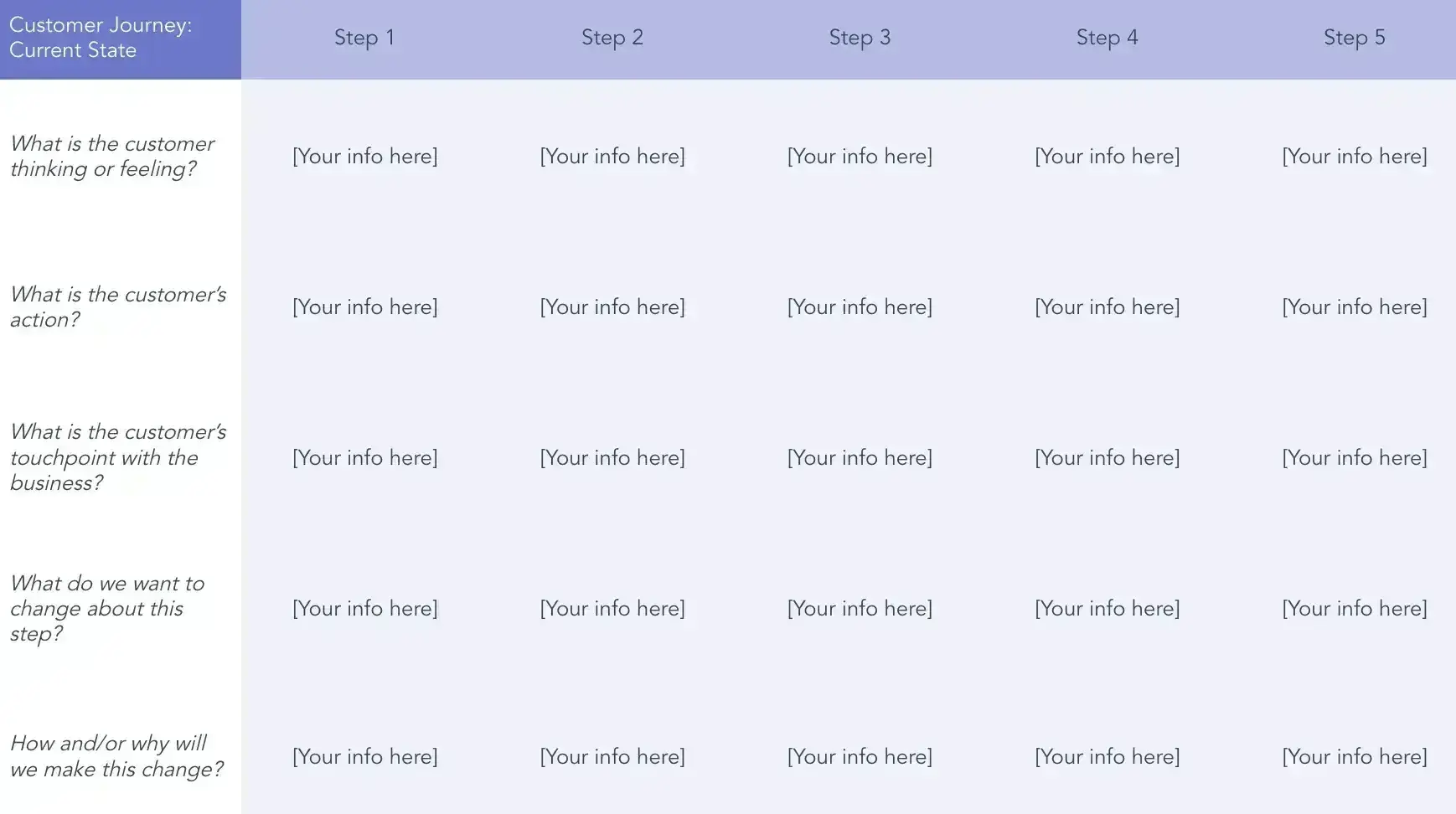
2. Day in the Life Template
In my experience, the real value of this “day in the life” template is that it helps you find opportunities your competitors are probably missing. By mapping a customer’s entire day, not just the moments they interact with your product, you get a roadmap of their actual needs and pain points.
Ultimately, this template gives you the context to stop just selling a product and start solving a real everyday problem for your customers. You can identify the perfect time to be helpful, which is how you build loyalty.
Get an interactive day in the life template.
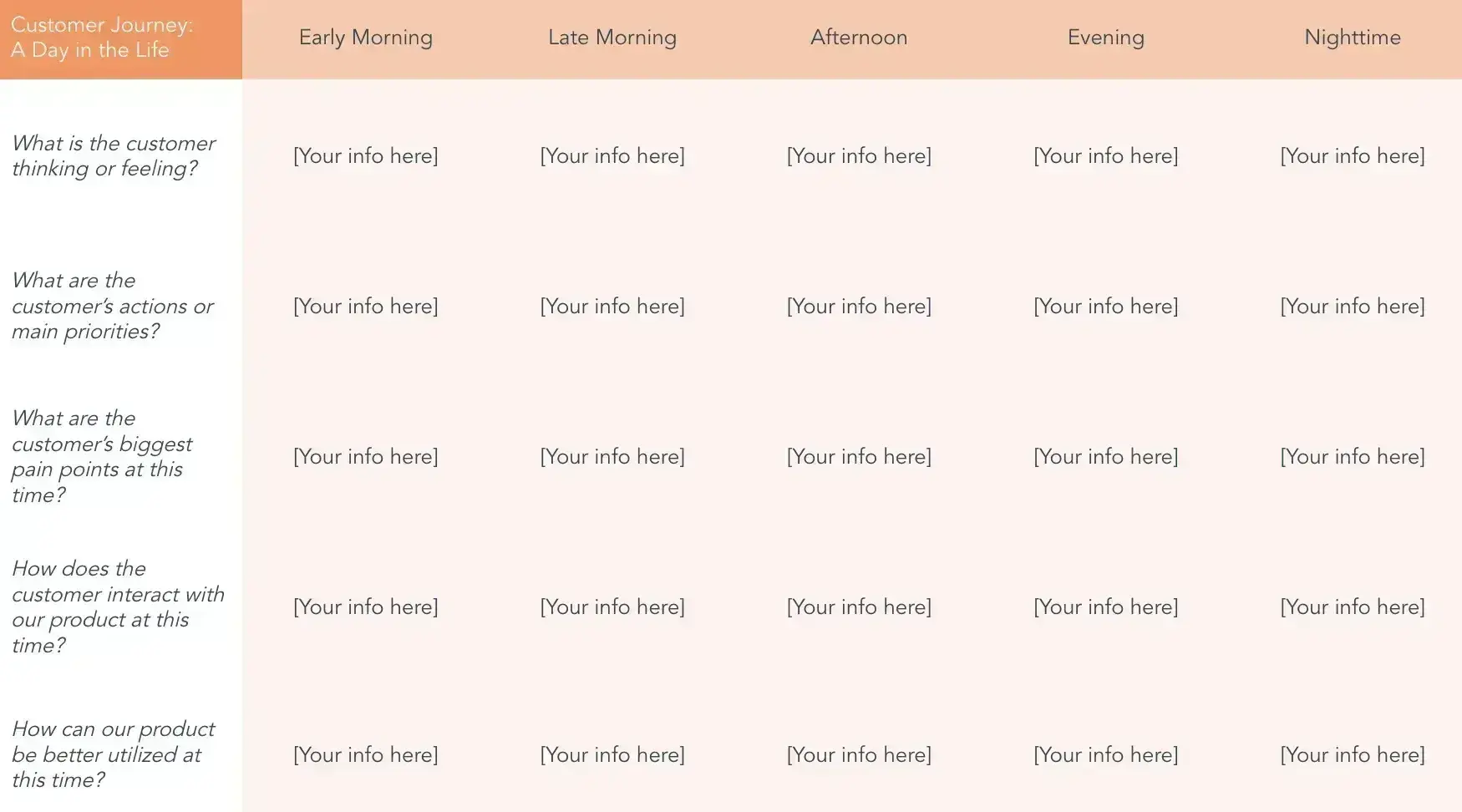
3. Future State Template
Like the current state template, these phases may reflect the predicted or desired search, awareness, consideration of options, purchasing decisions, and post-purchase support processes.
Since this will take place in the future, you can tailor these phases based on what you’d like the customer journey to look like rather than what it currently does.
Get an interactive future state template.
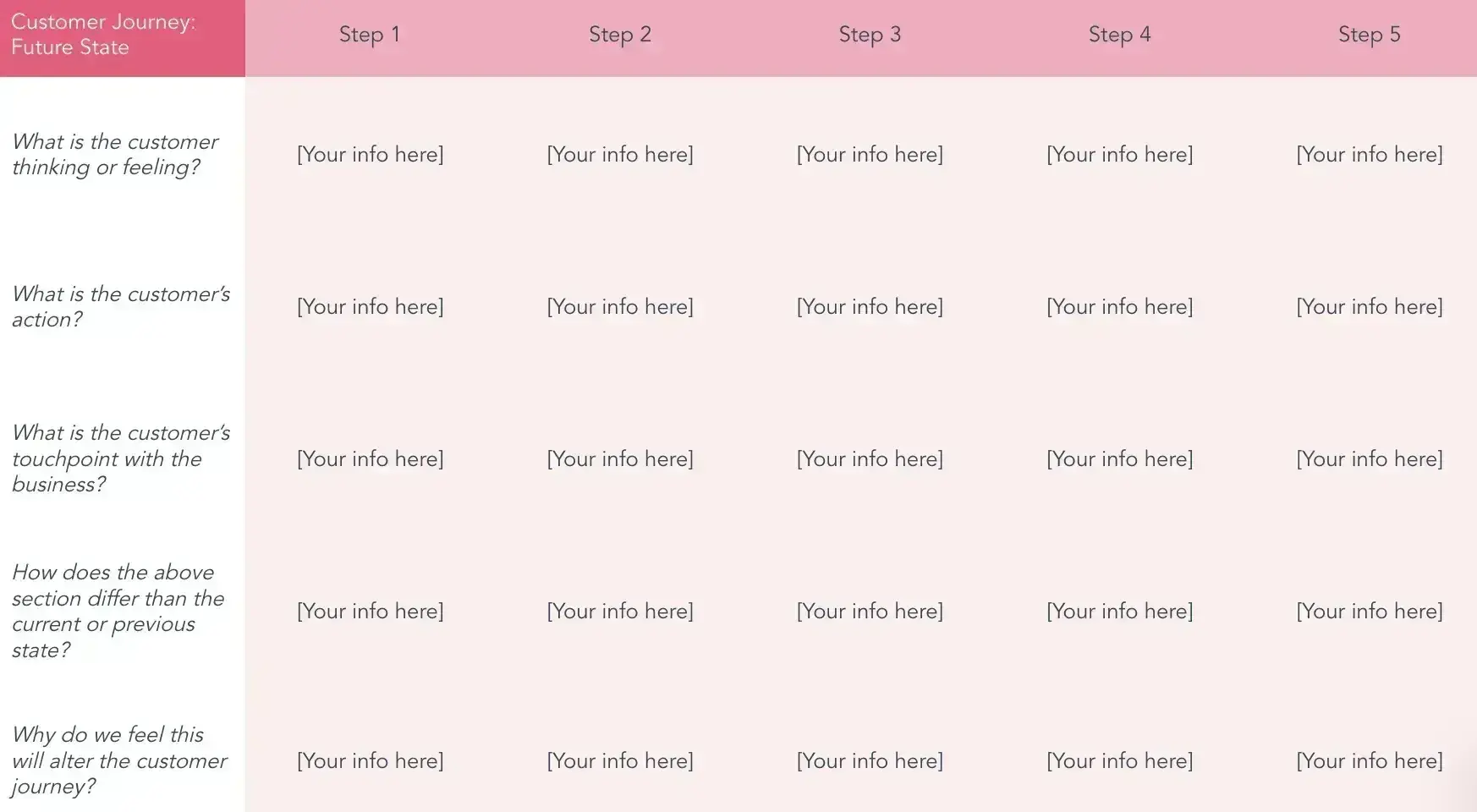
4. Service Blueprint Template
I’ve found the service blueprint template to be a very powerful tool for any service-based business. Its real value comes from connecting every tangible thing a customer experiences, from the menu they hold to the final bill, directly to your team’s actions.
The template forces you to map how a single customer action, like placing an order, triggers a whole chain of events for your front-end employees (like a waiter), back-end processes (the ordering system), and support staff (the kitchen).
This gives you a clear, end-to-end view of your operations. You can easily spot where an internal bottleneck is creating a poor experience, helping you find and fix the root cause of service issues you might have otherwise missed.
Get an interactive service blueprint template.
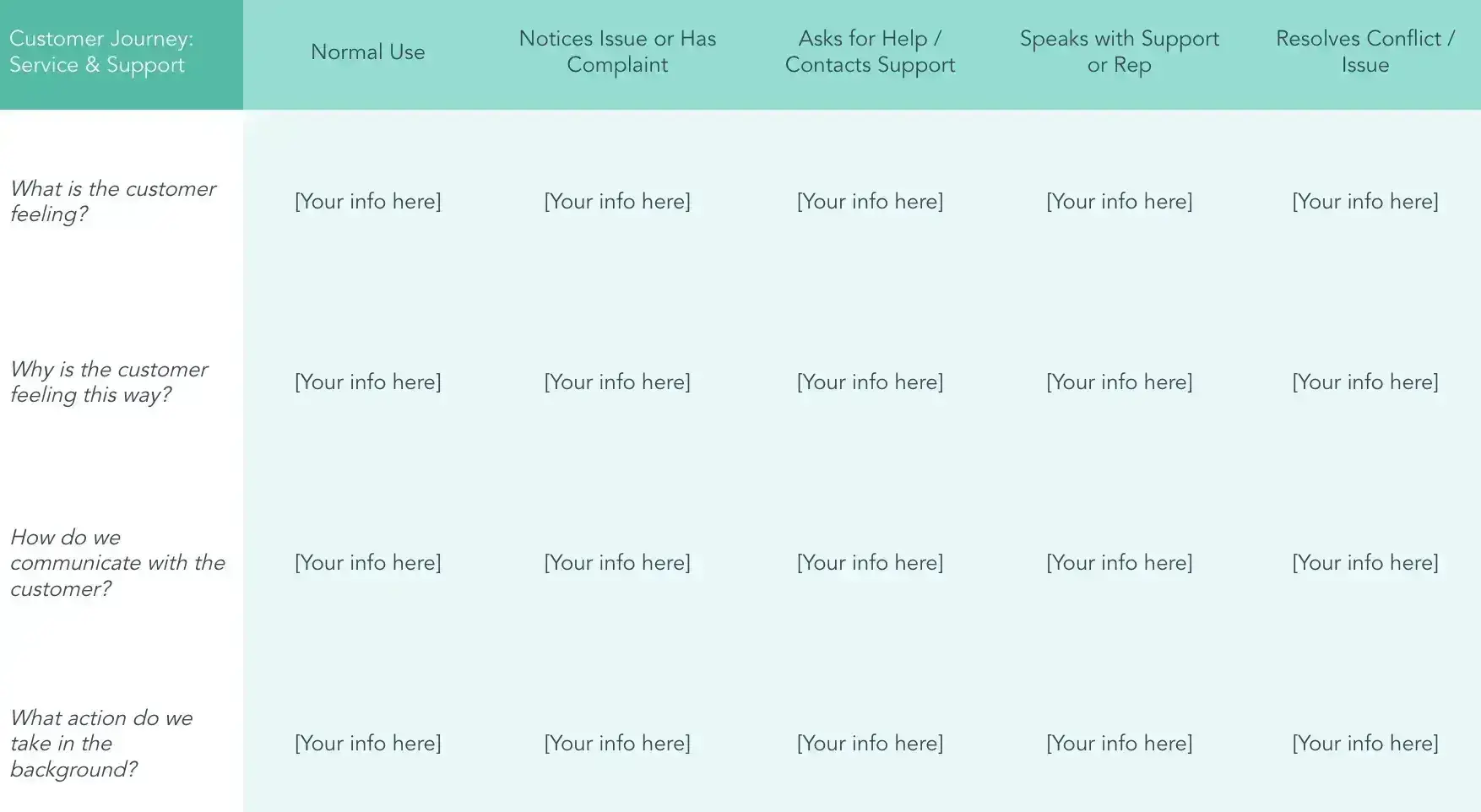
5. Buyer’s Journey Customer Journey Map Template
You can also use the classic buyer’s journey (awareness, consideration, and decision) to design your customer journey map. I’ve found this to be incredibly useful for aligning your marketing and sales efforts directly to what a potential customer is thinking and doing at each phase. It helps you answer critical questions like, ‘What content do they need right now?’ or ‘Where are they looking for information?’ so you can meet them exactly where they are in their journey.
Get an interactive buyer’s journey template.
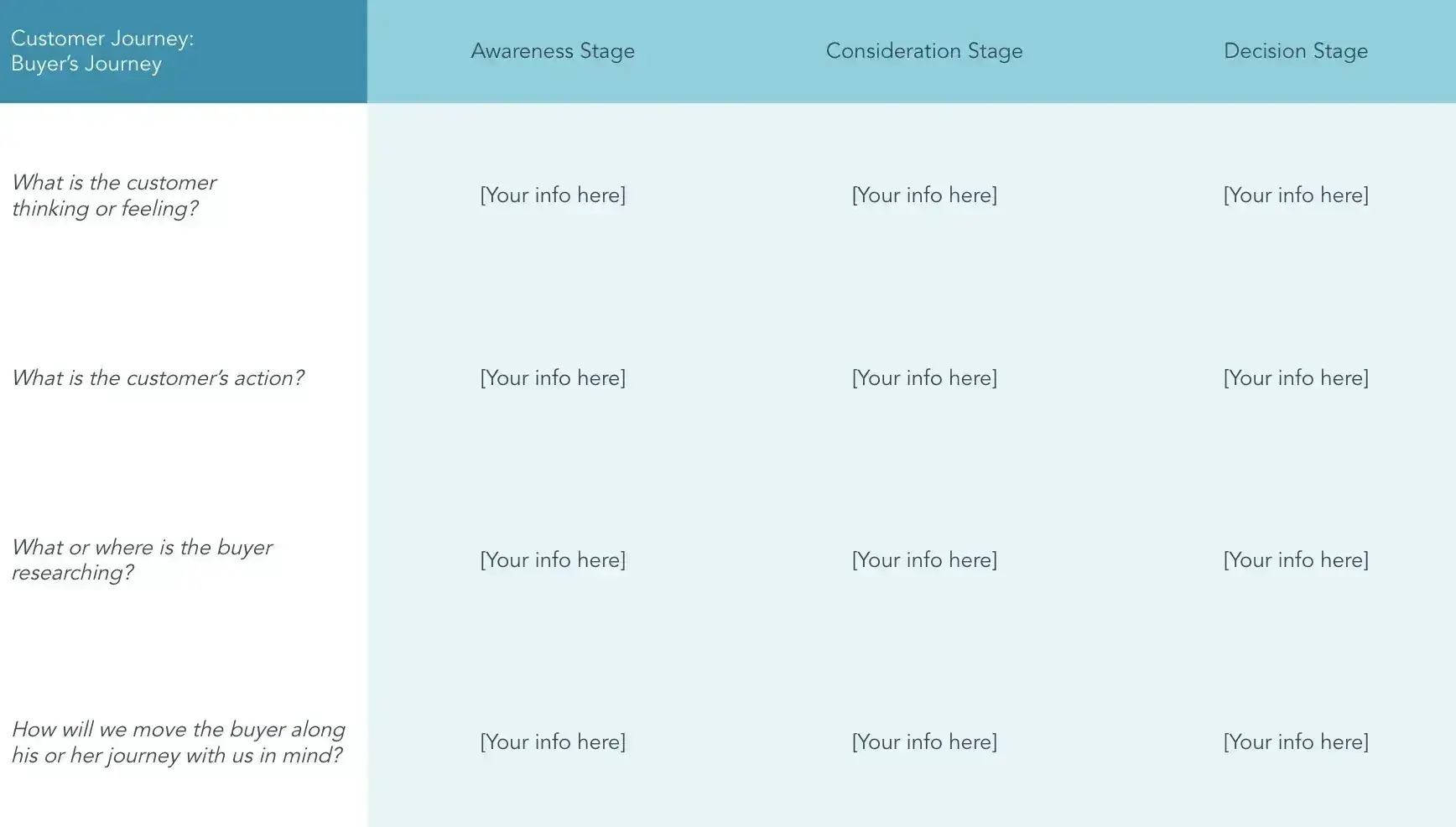
Over the years, I’ve developed a few core principles for journey mapping. Here are the ones I keep coming back to.
1. Set a goal for the journey map.
Before you dive in, you have to ask one simple question: What problem are we trying to solve with this map? Are you looking to smooth out the current buying experience, or are you charting the course for a completely new product launch? In my experience, getting crystal clear on the why from the beginning is what prevents these projects from spiraling out of control.
2. Survey customers to understand their buying journey.
I can’t stress this enough, but your assumptions about your customers are probably wrong. I’ve learned that what I think the buyer journey is and what the buyer is actually going through can be two totally different things. You have to speak directly with your customers to get an accurate, unfiltered snapshot of their experience, not the one you’ve imagined for them.
3. Ask customer service reps about the questions they receive most frequently.
Your customer service reps are an absolute goldmine for this process. They’re on the front lines every day, hearing about every point of confusion and frustration firsthand. I always make it a point to sit with them because they can translate those day-to-day customer struggles into clear, actionable friction points that you need to get on your map.
4. Consider customer journey mapping for each buyer persona.
Trying to create a single journey map for all your customers is a recipe for a generic, useless diagram. I’ve learned that a brand-new user on a free trial has a completely different set of needs and challenges than a power user on an enterprise plan. That’s why you have to create tailored maps for each key persona to get insights that are actually meaningful and actionable.
5. Review and update each journey map after every major product release.
Customer journey maps are not “set it and forget it” projects. Every time your product or service changes, the customer’s journey changes with it. I make it a rule to review our journey maps after major product releases to ensure our understanding of the customer experience stays current and accurate.
6. Make the customer journey map accessible to cross-functional teams.
Don’t keep your journey map locked away in a folder that only your team can see. I always make the final map accessible to everyone in the company. When you get it out there, it helps other teams give valuable feedback and, more importantly, it keeps everyone aligned and focused on the same ultimate goal… improving the customer’s experience.
If you want to get a head start on your map and analysis, try HubSpot’s tools and create a journey report.
Customer Journey Map Design
Now that you know what goes into making a customer journey map, let’s take a little time to dive into design. How you lay out your journey map makes a huge difference.
I’m not a designer, but I’ve learned a few things about making these maps effective:
Create a clear layout and hierarchy.
Your layout should flow logically, with a clear visual hierarchy that makes it easy to follow. Use bold headings to break up the sections and keep things readable.
Bullet points are your friend. They make your map easier to digest and keep the information clear and to the point.
Make the most of icons and symbols.
Let's be real, everyone skims. If your map is a wall of text, most will be missed. Icons and symbols are a great way to break things up and highlight key actions, touchpoints, and outcomes. Plus, they can add emotion to your map without needing extra words.
Use color coding.
Color is a powerful design element that can help you group similar ideas. You can assign different hues to the stages of your customer journey or to certain touchpoints. This helps you organize information visually and draw attention to the most important parts of your map.
Avoid clutter to create balance.
Too much of anything is just... too much. If your page is packed with icons, text, and colors, it’ll get overwhelming. Use whitespace to keep things balanced and organized.
Maintain consistency.
Your customer journey map should be consistent throughout. Pick a font family, color palette, and font sizes. Then, make sure you follow these guidelines throughout your journey map. Bonus points if your elements align with your company branding.
Benefits of Customer Journey Mapping
So, is all this worth it? Absolutely. Customer journey maps are something that every growing business should have, whether you’re a team of one or have hundreds of employees.
From my experience, here are the biggest, most tangible benefits you’ll see when you commit to truly understanding your customers’ journey.
1. Refocus your company with an inbound perspective.
Instead of shouting into the void with outbound marketing, a journey map helps you listen. It shows you what customers are actually looking for, what problems they’re trying to solve, and where they go for answers. This allows you to stop chasing customers and start attracting them by providing value exactly when and where they need it. It’s just a more efficient way to do business. Recent marketing data shows that inbound marketing generates three times more leads per dollar than traditional methods. By understanding the journey, you create content and experiences that draw people in naturally.
Pro tip: Take the pain points you’ve identified at each stage of your journey map and brainstorm one piece of content that solves that specific problem. If a pain point in the ‘Consideration Stage’ is “I don’t know how to compare the technical features,” that’s your cue to create a detailed comparison guide or explainer video.
2. Create a more precise and effective target customer base.
Journey mapping forces you to move beyond broad demographics and into the specifics of behavior and motivation. You stop seeing “millennials” and start seeing “price-conscious students looking for a durable solution” or “busy professionals who value fast, responsive support.” This deep understanding enables hyper-targeted segmentation. You can tailor your messaging, offers, and even product features to the people who will actually benefit from and pay for your product.
Pro tip: The best way to make your personas useful is to turn their behaviors into dynamic lists. I use tools like HubSpot’s list segmentation software to build these audiences directly in the CRM. For example, you can instantly target “busy professionals” by filtering for users who log in daily but ignore a key feature, making your personas actionable.
3. Implement proactive, not just reactive, customer service.
A journey map is like a cheat sheet for your support team. It shows you the common roadblocks and points of frustration before the customer even sends an angry email. Are users always stuck at a certain step in the setup process? Create a pop-up tutorial right there. Do they hesitate on the shipping page? Offer proactive clarification on costs. This is about being one step ahead.
It’s no surprise that 2024 data from Freshworks shows 87% of customers appreciate proactive outreach from a company. At Dapper Labs, we started anticipating volume based on new product drops and built AI chatbots to answer common questions and triage requests, which freed up our human agents for the truly complex issues.
Pro tip: Identify the top three points of friction on your journey map and set up automated triggers to help. For example, if a user hesitates on the pricing page for more than a couple minutes, automatically send a chat message offering to clarify the plans. This is a simple way to transform your map’s insights into proactive support.
4. Improve your customer retention rate.
It’s a business cliche because it’s true: it costs far more to acquire a new customer than to keep an existing one. A journey map is your best tool for improving retention. By smoothing out the bumps and eliminating friction, you create an experience that people want to return to. Fewer pain points mean fewer reasons for customers to look elsewhere.
The data is clear. A 2024 report by Qualtrics XM Institute found that a positive customer experience makes customers more than 2.7 times more likely to continue doing business with your brand.
Pro tip: Use your journey map to spot what I call “moments of silence.” This is when a customer skips a key step or becomes inactive. These are your earliest churn signals and the perfect opportunity to re-engage them with proactive support before they’re gone.
5. Build a customer-centric mindset across the company.
In my experience, one of the most powerful side effects of journey mapping is its ability to break down internal silos. When the engineering, marketing, sales, and support teams all look at the same map, they stop seeing the business from their department’s perspective and start seeing it from the customer’s.
Suddenly, an engineering decision isn’t just about technical debt, it’s about a point of friction for the user. A marketing campaign isn’t just about leads, it’s about setting the right expectations. Research from 2023 shows that companies with a strong customer-centric culture see up to 80% higher revenue. The journey map becomes a shared language that puts the customer at the center of every conversation.
Pro tip: Run a cross-functional workshop with people from engineering, marketing, sales, and success. Have each person add sticky notes to the journey map, identifying one opportunity and one friction point from their team’s perspective. I’ve found this is a fast way to create a shared ownership of the customer experience.
6. Rely on data and evidence, not just speculation.
In marketing and business, we all have gut feelings. But intuition, while valuable, isn’t foolproof. Customer journey maps force you to back up those feelings with evidence. They replace “I think users are confused here” with “We can see from the data that 40% of users drop off at this step.” This shift is transformative.
As email engagement and CRO specialist Alice Brown puts it, “Being able to triangulate your interview insights with survey responses and other sources of data means you‘re no longer relying on speculation or ICPs dreamed up in a boardroom to base your decisions on. Instead, touchpoints can be confidently built on data. This is how you create touchpoints that don’t just connect emotionally with your customers, but they also drive clicks and conversions.”
Pro tip: For every pain point on your map, try to write the hard data point right next to it. This turns a feeling into a fact that’s impossible for your team to ignore.
My Final Thoughts: Chartering the Path to Customer Success
After all this, what’s the big takeaway? For me, it’s that customer journey maps are more than flowcharts. They are tools for building empathy and being strategic. It forces you to talk in your customer’s shoes and see your business from their perspective.
I find that customer journey maps are most effective for visualizing this information, whether I’m optimizing the customer experience or exploring a new business opportunity to serve a customer’s unrecognized needs.
From my work in SaaS to gaming and e-commerce, the lesson has been the same. When you truly understand the journey, you can make it better. So use the free templates I’ve shared, get your team in a room with some sticky notes, and start mapping (a virtual board like Trello will do, considering WFH for many). It’s one of the most valuable exercises you can do for your business.
Editor's note: This article was originally published in August 2018 and has since been updated for comprehensiveness.
![How to Create an Effective Customer Journey Map [Examples + Template]-Feb-14-2022-08-21-04-79-PM](https://53.fs1.hubspotusercontent-na1.net/hub/53/hubfs/Google%20Drive%20Integration/How%20to%20Create%20an%20Effective%20Customer%20Journey%20Map%20%5BExamples%20+%20Template%5D-Feb-14-2022-08-21-04-79-PM.png?width=112&height=112&name=How%20to%20Create%20an%20Effective%20Customer%20Journey%20Map%20%5BExamples%20+%20Template%5D-Feb-14-2022-08-21-04-79-PM.png)
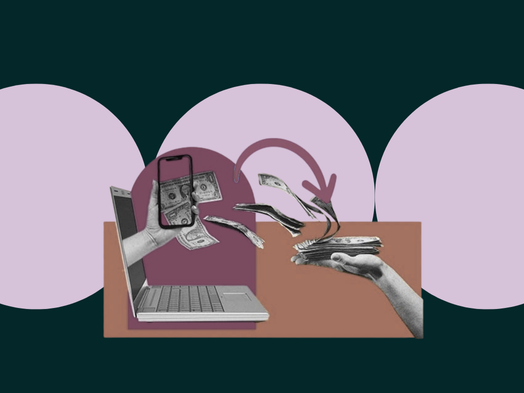

.webp)
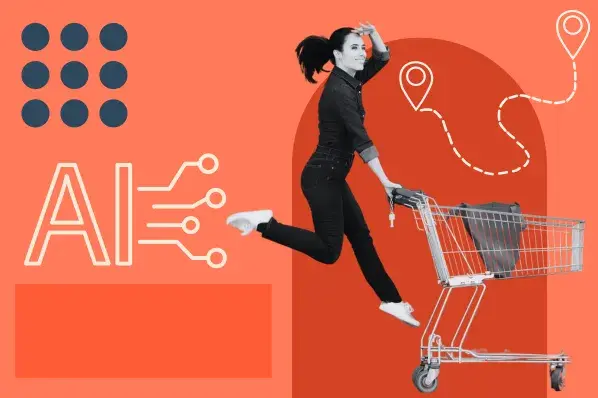


![Predicting Customer Behavior and AI: My Journey to Understanding the Customer Mind [+ Pro Tips]](https://53.fs1.hubspotusercontent-na1.net/hubfs/53/predicting-customer-behavior-1-20241119-9776241.webp)


![How to Create a Customer Experience Map [Free Templates]](https://53.fs1.hubspotusercontent-na1.net/hubfs/53/customer-experience-map.jpg)